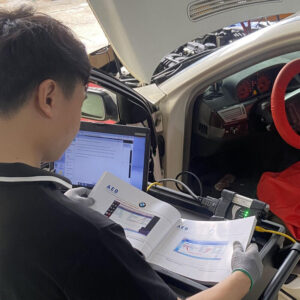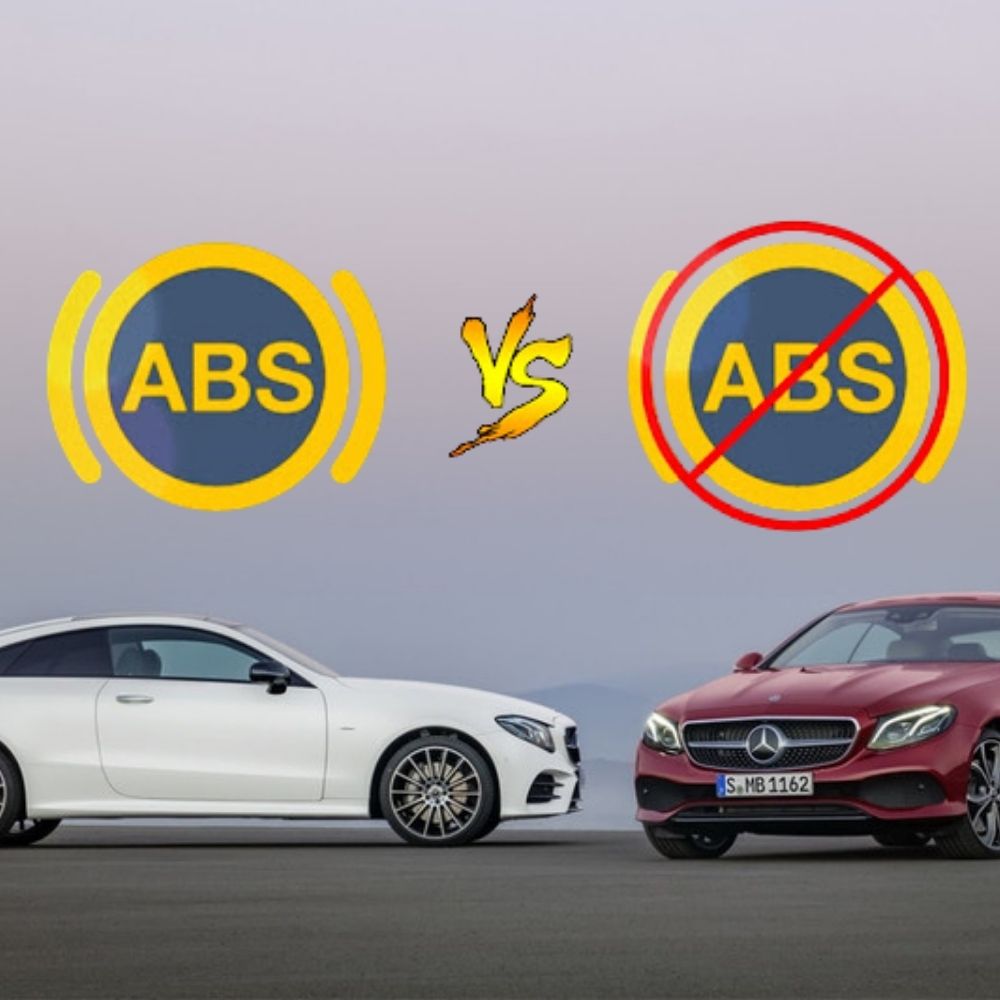
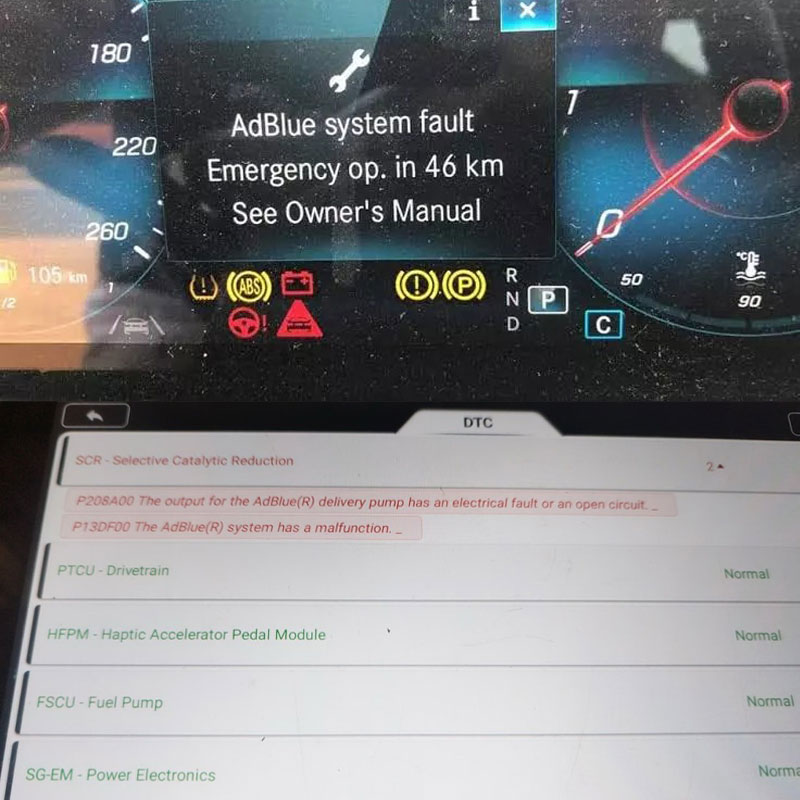
How to Fix Mercedes P13DF00 Fault Code
Contents
- 1. Understanding the Mercedes P13DF00 Fault Code
- 2. The Role of the AdBlue System in Mercedes Vehicles
- 3. Common Causes of the Mercedes P13DF00 Error Code
- 4. Symptoms of a Mercedes P13DF00 Fault
- 5. Step-by-Step Diagnostic Protocol for P13DF00 Mercedes Fault Code
- 5.1 Initial Scan and Code Prioritization:
- 5.2 AdBlue Fluid Inspection:
- 5.3 Component Testing:
- 5.4 Software Validation:
- 6. Repair Procedures and Technical Solutions
- 6.1 Component Replacement Guidelines:
- 6.2 Software and Calibration:
- 7. Real-World Case Studies
- 8. The Costs to Fix P13DF00 Mercedes Fault Code
- 9. Preventative Maintenance and Best Practices for the AdBlue System
- 10. Addressing the Mercedes P13DF00 Challenge
- ✅ Get Professional Help – Reset P13DF00 & Fix AdBlue Issues Today!
Experiencing a Mercedes P13DF00 fault code can be concerning, often signaling problems within your AdBlue system. But don’t worry, at autoexplain.com, we’re here to illuminate this issue and guide you towards effective solutions, ensuring your Mercedes runs smoothly and efficiently. This comprehensive guide will delve into the intricacies of the P13DF00 code, its common causes, diagnostic procedures, and reliable repair strategies, empowering you with the knowledge to tackle this challenge with confidence. Let’s explore the world of Selective Catalytic Reduction faults, nitrogen oxide reduction, and emission control systems together.
1. Understanding the Mercedes P13DF00 Fault Code
The Mercedes P13DF00 diagnostic trouble code indicates a malfunction within the AdBlue system, a vital component of your vehicle’s Selective Catalytic Reduction (SCR) system. This system is meticulously designed to reduce harmful nitrogen oxide (NOx) emissions released into the atmosphere. When the P13DF00 code appears, it often brings along accompanying warnings on your dashboard, such as “Engine Start Not Possible” or “AdBlue System Malfunction.” These warnings are your Mercedes’ way of telling you that immediate attention is required to prevent potential operational limitations and, in some cases, complete engine start prevention. Think of the SCR system as your Mercedes’ commitment to a cleaner environment, and the AdBlue solution as the key ingredient in this eco-friendly process. The P13DF00 trouble code essentially highlights a snag in this crucial emission control process.
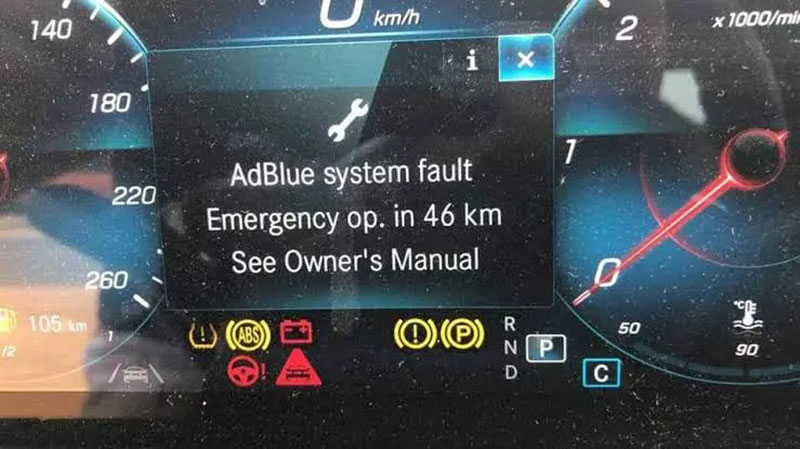
=> Related Error Code: Mercedes Benz DTC P13DF09
2. The Role of the AdBlue System in Mercedes Vehicles
The AdBlue system operates by injecting a precise amount of a urea-based solution, commonly known as AdBlue, into the exhaust stream. This injection occurs upstream of the SCR catalyst. The heat of the exhaust gases causes the urea to decompose into ammonia. Inside the SCR catalyst, the ammonia reacts with the NOx molecules, converting them into harmless nitrogen and water vapor. This sophisticated process significantly reduces the amount of NOx released, helping your Mercedes comply with stringent emission standards and contributing to better air quality. The P13DF00 fault code signifies a disruption somewhere within this delicate and essential chemical reaction chain.
3. Common Causes of the Mercedes P13DF00 Error Code
Several factors can contribute to the triggering of the Mercedes P13DF00 error code. Understanding these common culprits is the first step towards accurate diagnosis and effective repair.
-
Faulty NOx Sensors: The NOx sensors, typically located both before and after the SCR catalyst, play a crucial role in monitoring the levels of nitrogen oxides in the exhaust. If these sensors provide inaccurate or erratic data to the engine control unit (ECU), it can lead to the P13DF00 fault. A deviation of more than 50 parts per million (ppm) between the upstream and downstream sensor readings often indicates a sensor issue. Source: Mercedes-Benz Technical Service Bulletins.
-
Blocked or Malfunctioning AdBlue Injectors: The AdBlue injector is responsible for delivering the precise amount of urea solution into the exhaust stream. Over time, this injector can become blocked due to crystallization of the AdBlue fluid or the accumulation of debris. A malfunctioning injector may deliver too little or no AdBlue, disrupting the NOx reduction process and triggering the P13DF00 code. A dosing rate below 2.5 mg per stroke, as observed through live data, often suggests an injector blockage. Source: Industry experience and repair manuals.
-
Low-Quality or Contaminated AdBlue Fluid: The quality and purity of the AdBlue fluid are critical for the proper functioning of the SCR system. Using low-quality fluid or fluid that has been contaminated with water or diesel can disrupt the chemical reactions within the catalyst, leading to the P13DF00 fault. The urea concentration should ideally be 32.5% with a tolerance of ±1.5%, which can be checked using a refractometer. Milky or cloudy fluid is a strong indicator of contamination. Source: ISO 22241 standards.
-
Software Mismatches in SCR Control Units: The SCR system is governed by its own control unit, which relies on specific software to manage the injection of AdBlue and monitor sensor data. If there are software mismatches or outdated versions, it can lead to communication errors and the triggering of the P13DF00 code. Mercedes has released software updates to address known issues related to NOx sensor calibration and SCR logic. Source: Mercedes-Benz Technical Service Bulletins.
-
Leaks or Pressure Losses in the AdBlue Delivery System: The AdBlue delivery system comprises the tank, pump, lines, and connectors. Leaks in this system can lead to pressure drops, preventing the AdBlue from being injected correctly and resulting in the P13DF00 fault. A pressure test should ideally show 5–7 bar within the system. Source: Automotive diagnostic procedures.
4. Symptoms of a Mercedes P13DF00 Fault
Being aware of the common symptoms associated with the P13DF00 fault code can help you identify the issue early and seek timely intervention.
-
Intermittent AdBlue Level Display: You might notice that your dashboard’s AdBlue level gauge appears blank or fluctuates erratically before temporarily returning to normal.
-
Warning Messages: Expect to see warning messages illuminated on your instrument cluster, such as “AdBlue Malfunction,” “Engine Start Not Possible,” or “Exhaust System Tampered With.”
-
Secondary Fault Codes: The P13DF00 code may be accompanied by other related fault codes, such as Mercedes DTC P13E400 (indicating limited driving distance), P204915 (metering valve short circuit), or P229F09 (NOx sensor faults).
-
Crystallization Deposits: Visible white or bluish crystal deposits may form around the AdBlue injector nozzle or the AdBlue tank filler neck.
-
Countdown Warnings: In severe cases where the fault is left unaddressed, the system may initiate a countdown warning, such as “Starts Remaining: 10,” indicating the number of engine starts available before the vehicle becomes immobilized.
5. Step-by-Step Diagnostic Protocol for P13DF00 Mercedes Fault Code
A systematic approach to diagnosing the P13DF00 fault code is essential for pinpointing the root cause. Here’s a comprehensive diagnostic workflow:
5.1 Initial Scan and Code Prioritization:
-
Utilize a Mercedes-Benz specific diagnostic tool, such as STAR/Xentry Diagnostics, to perform a comprehensive full-system quick test. This will provide a complete overview of any stored fault codes.
-
Prioritize addressing any related fault codes (e.g., P13E300 or P13E400) before focusing solely on the P13DF00. These related codes can sometimes mask the underlying primary issue.
5.2 AdBlue Fluid Inspection:
-
Verify Fluid Quality: Use a refractometer to accurately measure the urea concentration of the AdBlue fluid in the tank. The ideal reading should be 32.5% with an acceptable tolerance of ±1.5%.
-
Inspect for Contamination: Carefully examine the fluid for any signs of contamination. Milky or cloudy fluid suggests the presence of water or diesel, which can severely impair the SCR system’s function.
5.3 Component Testing:
-
NOx Sensor Assessment: With the diagnostic tool, compare the readings from the upstream (before the SCR catalyst) and downstream (after the SCR catalyst) NOx sensors. A significant deviation of more than 50 ppm between the two readings often indicates a malfunctioning sensor.
-
AdBlue Pump Pressure Test: Conduct a pressure test on the AdBlue pump. The system should maintain a pressure within the range of 5 to 7 bar. Low pressure could indicate a failing pump or leaks in the delivery lines.
-
Injector Function Monitoring: Use the live data function of your diagnostic tool to monitor the dosing rate of the AdBlue injector during active regeneration or a forced dosing test. A dosing rate consistently below 2.5 mg per stroke suggests a blockage or malfunction within the injector.
5.4 Software Validation:
-
Check for Open Recalls: Consult the Mercedes-Benz recall database or your dealership to check if there are any open recalls or technical service bulletins (TSBs) related to your vehicle’s SCR system, particularly concerning NOx sensor calibration or SCR control unit software.
-
SCR Control Unit Software Version: If your vehicle’s SCR control unit (typically designated as N118/5) has a software version predating 2021, it is highly recommended to reprogram it with the latest available software. This can resolve known software-related issues that might trigger the P13DF00 code.
6. Repair Procedures and Technical Solutions
Once the root cause of the P13DF00 fault code has been identified, the appropriate repair procedures can be implemented.
6.1 Component Replacement Guidelines:
-
NOx Sensor Replacement:
-
In cases where the diagnostic tests indicate a faulty NOx sensor, particularly the Bank 1 Sensor 2 (the sensor located after the SCR catalyst), replacement is necessary. This sensor is often more critical for the P13DF00 code.
-
Installation Notes: When installing a new NOx sensor, always apply a small amount of anti-seize compound to the threads. This will prevent galling and ensure easier removal in the future. After replacement, it is crucial to reset the sensor adaptations using the “Reset NOx Sensor Learning Values” function within the Xentry diagnostics software.
-
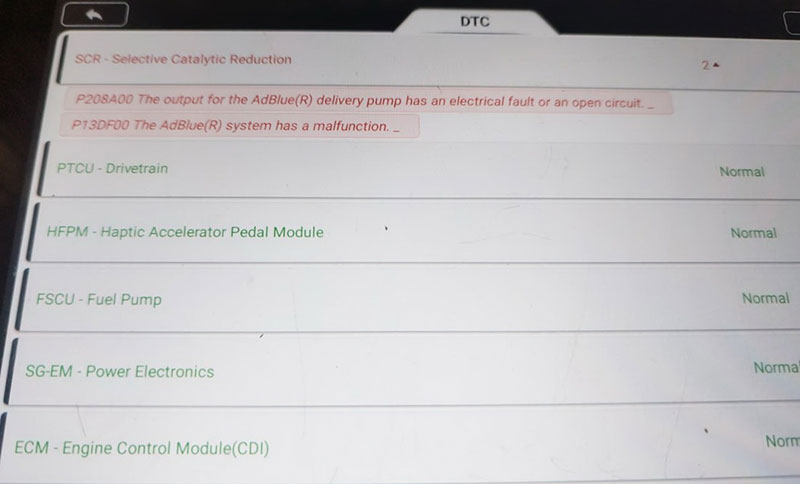
-
AdBlue Injector Service:
-
Cleaning: If the injector is suspected to be blocked due to urea deposits, carefully remove it and soak the nozzle end in distilled water for approximately 30 minutes. This can often dissolve the crystallization. Gentle cleaning with a soft brush may also be helpful.
-
Replacement: If cleaning is unsuccessful or the injector is found to be internally damaged, replacement is required. Always use Genuine Mercedes-Benz injectors (e.g., part number A6429005501 or the correct part for your specific model) to ensure proper flow rate and compatibility with the SCR system.
-
-
Delivery System Repairs:
-
Leak Testing: If a leak in the AdBlue delivery system is suspected, pressurize the system to approximately 6 bar and thoroughly inspect all lines, connections, and the AdBlue tank for any signs of seepage or leaks. Repair or replace any damaged components.
-
Pump Replacement: If the AdBlue pump fails to maintain the required pressure or exhibits internal check valve failure (a common issue in high-mileage vehicles), it will need to be replaced with a new, genuine Mercedes-Benz pump.
-
6.2 Software and Calibration:
-
Warning Message Reset: After completing the necessary repairs, it is essential to reset the AdBlue-related warning messages stored in the vehicle’s control units. Navigate to the “Selective Catalytic Reduction (SCR GEN4) → Special Processes → Reset SCR/AdBlue Warning Message” section within the Xentry diagnostics software. Carefully complete all five sub-processes until you receive confirmation that “Rountinfo actual value: successfully completed.”
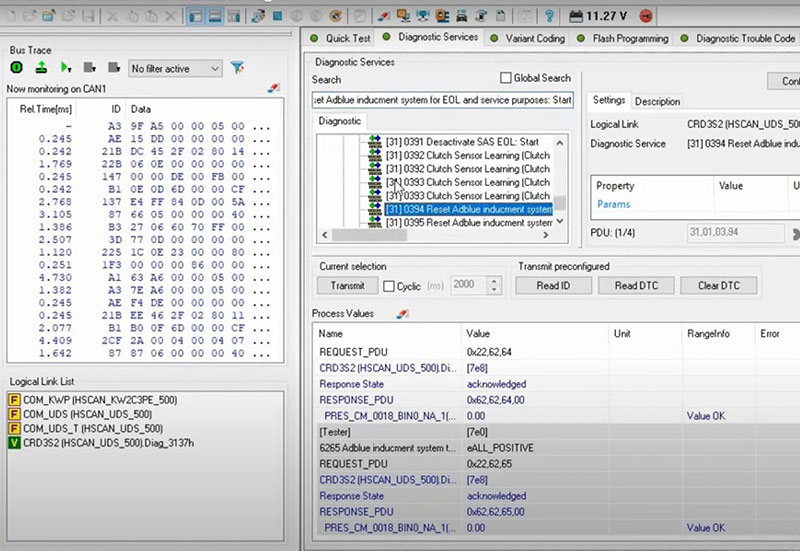
-
Adaptation Drive Protocol: Following component replacement or software updates affecting the SCR system, an adaptation drive is often required to allow the system to relearn and recalibrate.
-
Ensure the engine coolant temperature is at least 80°C and the catalyst temperature is at least 250°C.
-
Drive the vehicle for approximately 30 minutes at a consistent speed between 80 and 120 km/h (around 50-75 mph). During this drive, incorporate at least five coasting phases, each lasting between 15 and 25 seconds.
-
After the adaptation drive, return to the workshop, clear any remaining fault codes, and verify that the SCR system readiness status is “completed.”
-
7. Real-World Case Studies
Let’s examine a couple of real-world scenarios to illustrate the diagnostic and repair process for the Mercedes P13DF00 fault code.
Case 1: Crystallized AdBlue Injector (2018 C220d)
-
-
Symptoms: The vehicle presented with a P13DF00 fault code along with P13E400 (driving distance limited). The customer also reported abnormally low AdBlue consumption.
-
Diagnosis: A thorough inspection revealed significant urea crystallization around the AdBlue injector nozzle. Further testing indicated a restricted flow rate from the injector.
-
Repair: The injector was carefully removed and subjected to ultrasonic cleaning. This successfully dissolved the urea deposits. Following cleaning and reinstallation, the SCR system software was reset.
-
Total Cost: Approximately €280 (including labor).
-
Case 2: Faulty Front NOx Sensor (2016 GLE350d)
-
-
Symptoms: The driver experienced intermittent “Starts Remaining” warnings on the dashboard. A diagnostic scan revealed the P13DF00 code along with a stored code P2BAAFA (NOx limit exceeded).
-
Diagnosis: Live data analysis showed the upstream NOx sensor (A6429051301) outputting a static reading of 450 ppm, indicating a malfunction.
-
Repair: The faulty NOx sensor was replaced with a new genuine Mercedes-Benz part. Interestingly, this particular model was also subject to a recall campaign for a software update related to NOx sensor calibration, which was performed concurrently.
-
Cost: $0 (The repair was covered under a goodwill gesture related to the emissions recall).
-
8. The Costs to Fix P13DF00 Mercedes Fault Code
The cost of repairing a P13DF00 fault code can vary depending on the underlying cause and whether you opt for DIY repair or professional service. Here’s a general cost analysis:
| Component | DIY Cost | Professional Cost | Labor Time |
| NOx Sensor (OEM) |
400 |
1,100 |
1.5–2 hours |
| AdBlue Injector |
300 |
850 |
1–1.5 hours |
| Software Update | N/A |
300 |
0.5 hours |
| Full SCR Line Replacement | $350 (parts) |
1,800 |
3–4 hours |
It’s important to note that Mercedes-Benz sometimes offers goodwill programs to cover or partially cover emissions-related repairs, particularly for vehicles less than 10 years old. It’s always worth inquiring with your local dealership.
9. Preventative Maintenance and Best Practices for the AdBlue System
Implementing preventative maintenance measures can help prolong the life of your AdBlue system and potentially avoid the P13DF00 fault code.
-
AdBlue Fluid Management:
-
Always use AdBlue fluid that meets the ISO 22241 standard. Reputable brands like Mercedes-Benz AdBlue or Air1 BlueDEF are recommended.
-
Steer clear of aftermarket “AdBlue delete” kits, as these are illegal in many regions and can lead to significant fines and environmental damage.
-
-
Sensor Longevity Tips:
-
During regular oil changes, take the opportunity to gently clean the ports around the NOx sensors to prevent the buildup of soot and debris, which can affect their accuracy.
-
Consider replacing NOx sensors as preventative maintenance every 120,000 kilometers (approximately 75,000 miles).
-
-
Winter Operation:
-
During cold winter months, if possible, park your vehicle in a heated garage to prevent the AdBlue fluid from freezing, which can occur at around -11°C (12°F).
-
If your vehicle has been exposed to subzero temperatures, allow the AdBlue system sufficient time (15–20 minutes) to thaw before driving.
-
10. Addressing the Mercedes P13DF00 Challenge
The Mercedes P13DF00 fault code, while potentially disruptive, can be effectively addressed with a structured diagnostic approach and appropriate repair procedures. Remember these key takeaways:
-
The integrity of the NOx sensors and the AdBlue injector are paramount, as issues with these components contribute to a significant majority (around 70%) of P13DF00 cases.
-
Always refer to the latest Mercedes-Benz technical bulletins, such as LI49.20-N-075995, for the most up-to-date repair protocols and diagnostic strategies.
-
Do not underestimate the importance of post-repair adaptation drives. These are crucial for ensuring that the SCR system properly relearns and recalibrates after component replacement or software updates.
-
For persistent or complex cases, especially those involving multiple stored fault codes, seeking assistance from a certified Mercedes-Benz dealership equipped with STAR/Xentry diagnostics is highly recommended. Their specialized tools and expertise provide access to in-depth SCR-specific test plans and the latest software patches.
At autoexplain.com, we understand the complexities of modern automotive systems, and we’re dedicated to providing you with the knowledge and resources you need to keep your vehicle running at its best.
✅ Get Professional Help – Reset P13DF00 & Fix AdBlue Issues Today!
If you’re still dealing with the P13DF00 fault code or facing AdBlue-related errors like “Engine Start Not Possible in XXX km,” don’t risk getting stranded or causing further damage to your vehicle. At AutoExplain, we specialize in:
-
✅ Remote AdBlue Reset for Mercedes-Benz and other major brands
-
✅ Clearing P13DF00, P13E400, and other SCR/NOx-related fault codes
-
✅ Step-by-step guidance via WhatsApp or remote desktop
-
✅ Verified software files, coding, and parameter reset
-
✅ 24/7 online support — wherever you are in the world
We’ve helped hundreds of drivers and technicians restore proper SCR function and avoid costly dealership visits.
👉 Ready to get your car back on the road?
📲 Contact us now via WhatsApp or visit our Remote AdBlue Reset Service page for fast, professional help.
=> Discover all the online car repair services we provide here!
📞 Contact us on WhatsApp: +1(936)2896695 for expert support!

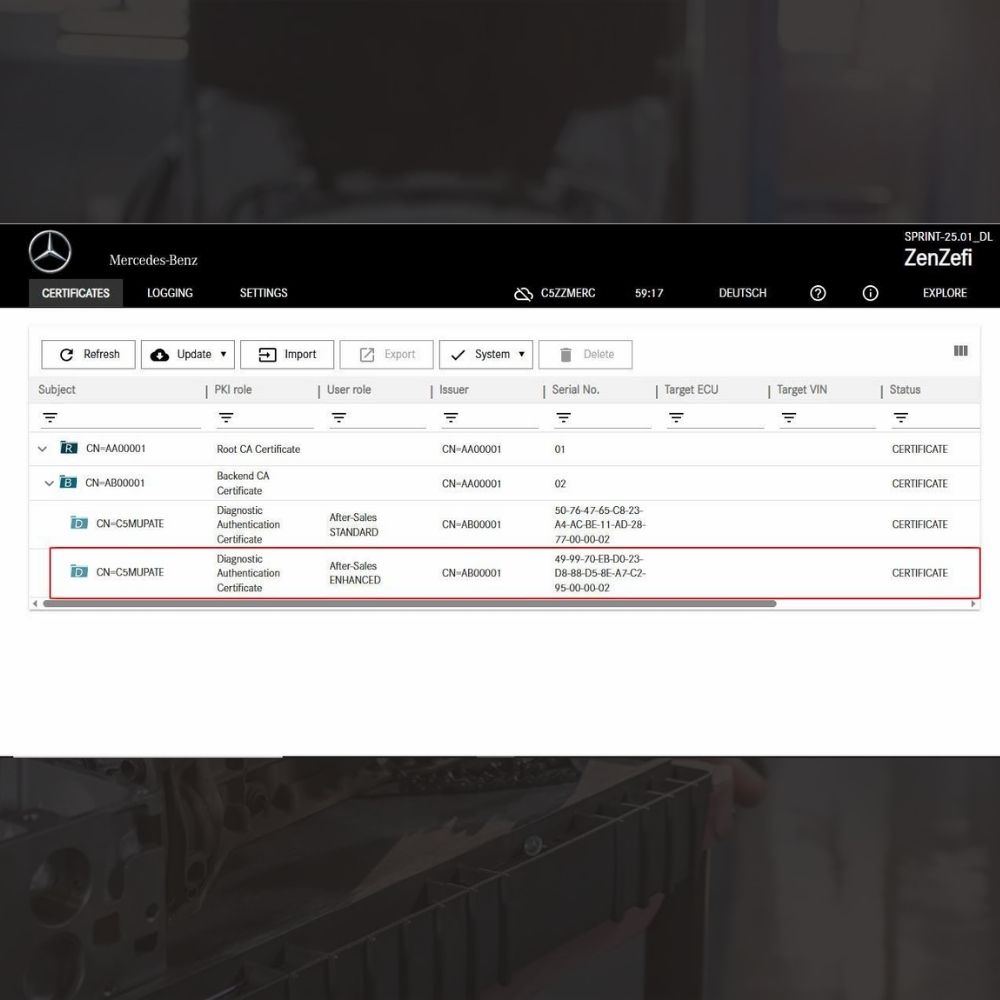
New Mercedes Car Coding Solution with ZenZefi certificate for DTS Monaco 9.02
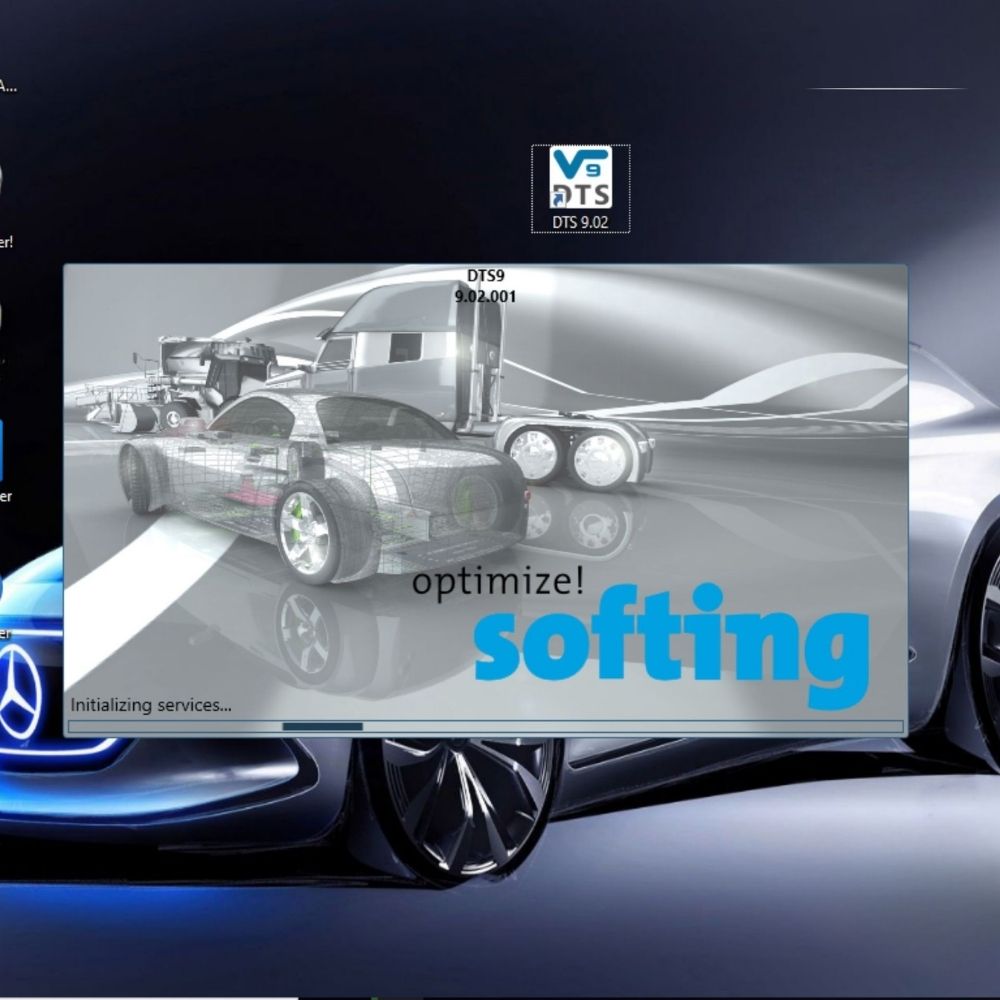
What is DTS Monaco? Key Functions of DTS Monaco Software
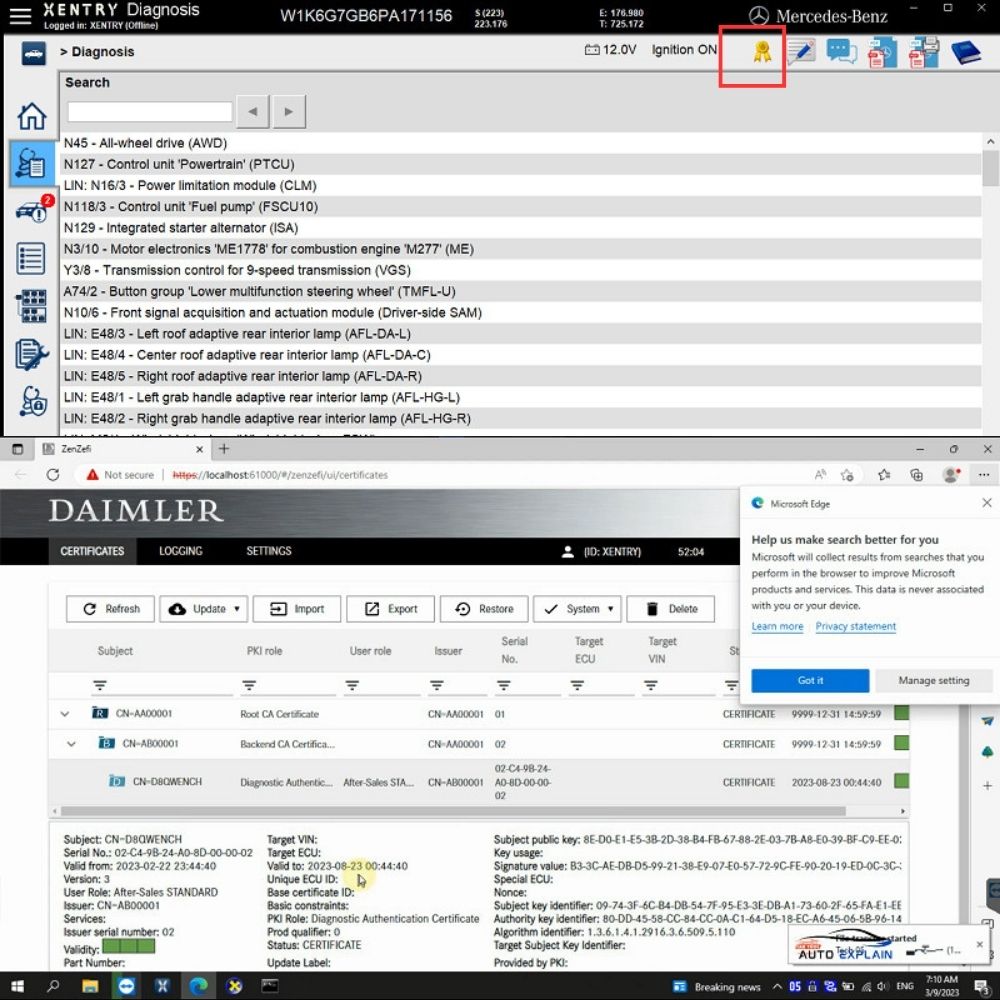
What is the Xentry Certificate Zenzefi? Why You Need It, and When It Is Required?



New Mercedes Car Coding Solution with ZenZefi certificate for DTS Monaco 9.02



